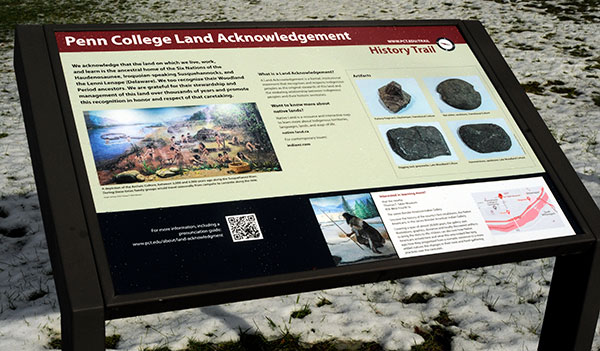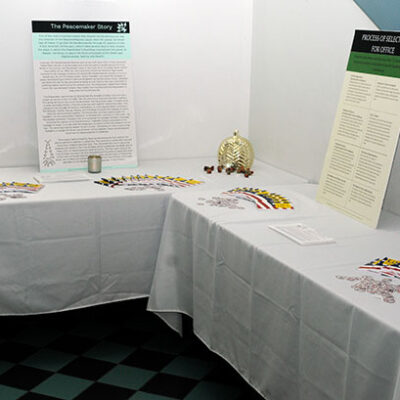Land Acknowledgement marker added to college History Trail
Wednesday, November 16, 2022
A lunchtime program Wednesday celebrated Penn College's Land Acknowledgement, including an official History Trail marker newly installed just outside the Bush Campus Center's west entrance.
“We acknowledge that the land on which we live, work and learn is the ancestral home of the Six Nations of the Haudenosaunee, Iroquoian-speaking Susquehannocks and the Lenni Lenape (Delaware). We, too, recognize their Woodland Period ancestors,” the acknowledgement reads. “We are grateful for their stewardship and management of this land over thousands of years and promote this recognition in honor and respect of that caretaking.” The day's program – organized by Meghan Delsite Coleman, assistant director of student engagement – coincided with Native American History Month, held each November to honor the nation's Indigenous cultures.
The day's program – organized by Meghan Delsite Coleman, assistant director of student engagement – coincided with Native American History Month, held each November to honor the nation's Indigenous cultures. "The development of our Land Acknowledgement was a labor of love," said Elliott Strickland, vice president for student affairs. "We work to ensure Penn College honors and celebrates all of our diversity so that we can create a community where everyone has a place and can be seen and heard. And we believe this should include those that are here today, that will come in the future and, most relevant today, those that have preceded us."
"The development of our Land Acknowledgement was a labor of love," said Elliott Strickland, vice president for student affairs. "We work to ensure Penn College honors and celebrates all of our diversity so that we can create a community where everyone has a place and can be seen and heard. And we believe this should include those that are here today, that will come in the future and, most relevant today, those that have preceded us."
Strickland noted those who were instrumental in the Land Acknowledgement (some of whom were on hand): John F. Chappo, assistant professor of history; Craig A. Miller, associate professor of history/political science; Allison Bressler Grove, director of student engagement; Sammie L. Davis, former coordinator of diversity and student engagement; Thomas "Tank" Baird, president of North Central Chapter #8 of the Society for Pennsylvania Archaeology; Gary W. Parks, executive director of the Thomas T. Taber Museum; and Sarah K. Patterson, graphic designer/project coordinator. He also thanked Jarred J. Jones, a member of the Shinnecock and Montaukett peoples of Long Island, New York, who sat on the Land Acknowledgement Committee while still a student in the Spring 2021 semester.
He also thanked Jarred J. Jones, a member of the Shinnecock and Montaukett peoples of Long Island, New York, who sat on the Land Acknowledgement Committee while still a student in the Spring 2021 semester. “There are many people who remain unrecognized, and Native Americans fall under that category far too often," the now-alumnus (applied management and automotive technology) said at the time. "Particularly in recent years, with social and civic divide increasing dramatically, sometimes people don’t realize just how many people are forgotten about.”
“There are many people who remain unrecognized, and Native Americans fall under that category far too often," the now-alumnus (applied management and automotive technology) said at the time. "Particularly in recent years, with social and civic divide increasing dramatically, sometimes people don’t realize just how many people are forgotten about.”
After the remarks, attendees could sample food from Tomahawks, a Mifflinburg restaurant that features Native American cuisine; visit the outdoor marker; mingle among information and display tables in the CC lobby; and obtain free tickets to the Lycoming County Historical Society Museum (within walking distance of campus).
